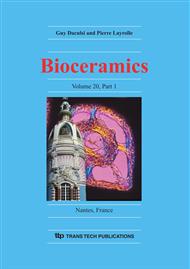p.1139
p.1143
p.1149
p.1153
p.1157
p.1161
p.1165
p.1169
p.1173
Mechanical Properties of Living Cells: Interaction of the Adherent Endothelial Cell and the Fluid Shear Flow
Abstract:
In present study a theoretical model was established to simulate the interaction between the adherent endothelial cell and fluid shear flow. A two-dimensional computational fluid dynamics (CFD) was conducted to solve the model equations. The results showed that the model cell was deformed under steady shear flow. It spread along the flow direction, and decreased its height. The deformation index (DI) increased with Reynolds number of applied fluid flow. The DI of the cell increased greatly when the initial contact angle (α) was smaller than 130°, and then it was less important with the increase of α. These results suggest that the fluid shear flow may play a particular role in the mechanism of cell activation and in the regulation of endothelial cells functions.
Info:
Periodical:
Pages:
1157-1160
Citation:
Online since:
November 2007
Authors:
Keywords:
Price:
Сopyright:
© 2008 Trans Tech Publications Ltd. All Rights Reserved
Share:
Citation:


